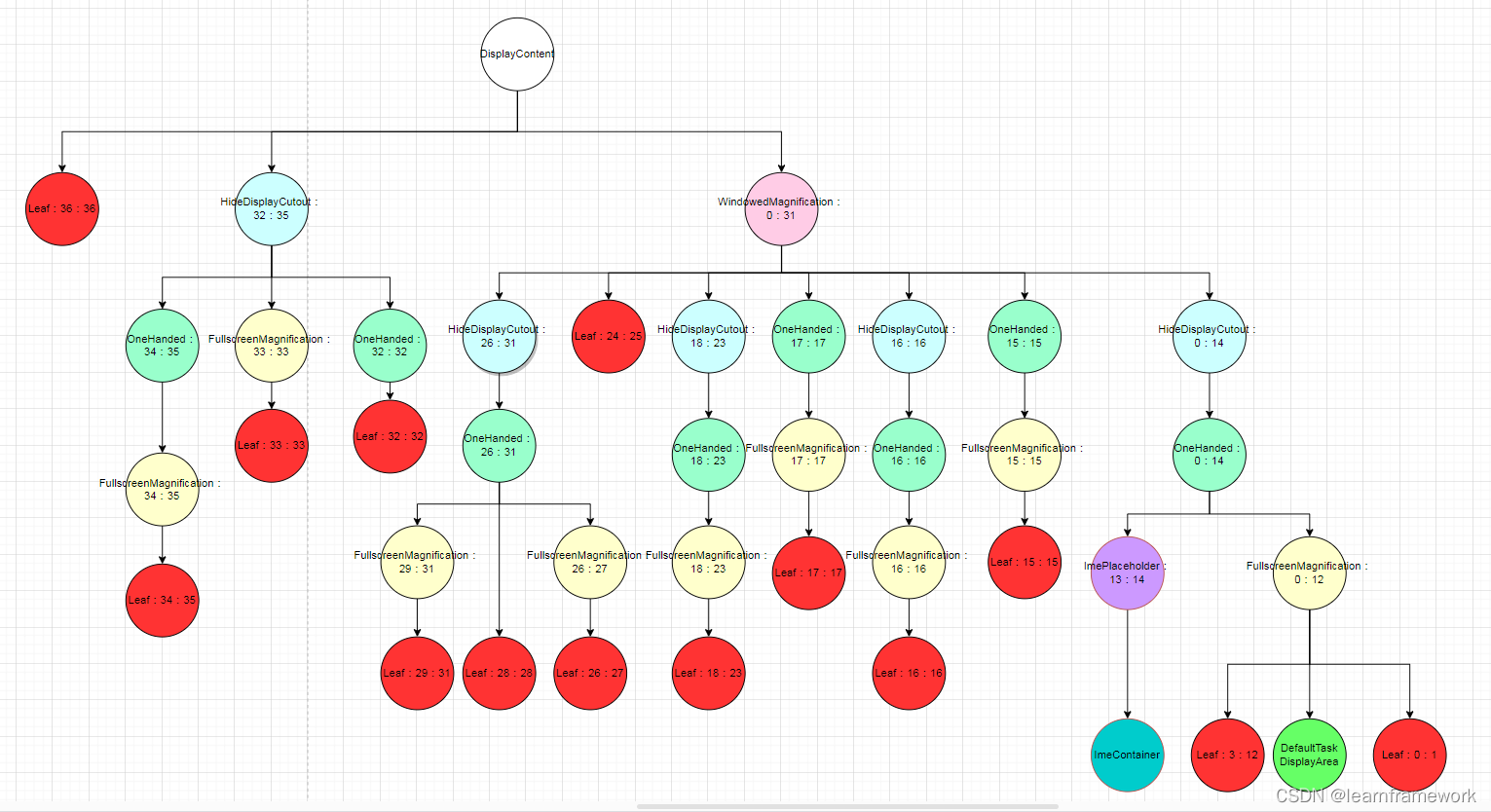
android 13 WMS/AMS系统开发-窗口层级相关DisplayArea,WindowContainer第二节
接着上一节课学习,我们已经清楚的知道了层级结构应该怎么看,根据dumpsys的输出可以完美复原出层级结构树,也理解了结构树对于层级结构的控制作用。但还没有从源码部分对这个结构树进行一个分析,即分析生成这个结构树的源码部分。
接着上一节课学习,我们已经清楚的知道了层级结构应该怎么看,根据dumpsys的输出可以完美复原出层级结构树,也理解了结构树对于层级结构的控制作用。但还没有从源码部分对这个结构树进行一个分析,即分析生成这个结构树的源码部分。
1、DisplayContent中启动层级树的构建
/**
* Create new {@link DisplayContent} instance, add itself to the root window container and
* initialize direct children.
* @param display May not be null.
* @param root {@link RootWindowContainer}
*/
DisplayContent(Display display, RootWindowContainer root) {
super(root.mWindowManager, "DisplayContent", FEATURE_ROOT);
//ignore
//实际调用这里surface相关图层配置,因为显示东西都需要Surfaceflinger
configureSurfaces(pendingTransaction);
//ignore
}
private void configureSurfaces(Transaction transaction) {
//ignore
if (mDisplayAreaPolicy == null) {
// Setup the policy and build the display area hierarchy.
// Build the hierarchy only after creating the surface so it is reparented correctly
//实际调用这里进行DisplayArea构建
mDisplayAreaPolicy = mWmService.getDisplayAreaPolicyProvider().instantiate(
mWmService, this /* content */, this /* root */,
mImeWindowsContainer);
}
//ignore
}
结下来调用是实现类DefaultProvider的instantiate
frameworks/base/services/core/java/com/android/server/wm/DisplayAreaPolicy.java
public DisplayAreaPolicy instantiate(WindowManagerService wmService,
DisplayContent content, RootDisplayArea root,
DisplayArea.Tokens imeContainer) {
//创建特殊的TaskDisplayArea,这里我们前面讲过它是专门来装Activity相关的容器
final TaskDisplayArea defaultTaskDisplayArea = new TaskDisplayArea(content, wmService,
"DefaultTaskDisplayArea", FEATURE_DEFAULT_TASK_CONTAINER);
final List<TaskDisplayArea> tdaList = new ArrayList<>();
tdaList.add(defaultTaskDisplayArea);
// Define the features that will be supported under the root of the whole logical
// display. The policy will build the DisplayArea hierarchy based on this.
final HierarchyBuilder rootHierarchy = new HierarchyBuilder(root);
// Set the essential containers (even if the display doesn't support IME).
//这里同时setImeContainer进行输入法直接容器设置
rootHierarchy.setImeContainer(imeContainer).setTaskDisplayAreas(tdaList);
if (content.isTrusted()) {//主屏幕肯定进入,也是构成层级关键
// Only trusted display can have system decorations.
configureTrustedHierarchyBuilder(rootHierarchy, wmService, content);
}
return new DisplayAreaPolicyBuilder().setRootHierarchy(rootHierarchy).build(wmService);
}
上面可以看出主要有以下部分
1、构建HierarchyBuilder对象
2、准备TaskDisplayArea
3、准备好imeContainer
4、识别屏幕情况,进入configureTrustedHierarchyBuilder
5、配置完成进入build
先看configureTrustedHierarchyBuilder
private void configureTrustedHierarchyBuilder(HierarchyBuilder rootHierarchy,
WindowManagerService wmService, DisplayContent content) {
// WindowedMagnification should be on the top so that there is only one surface
// to be magnified.
rootHierarchy.addFeature(new Feature.Builder(wmService.mPolicy, "WindowedMagnification",
FEATURE_WINDOWED_MAGNIFICATION)
.upTo(TYPE_ACCESSIBILITY_MAGNIFICATION_OVERLAY)
.except(TYPE_ACCESSIBILITY_MAGNIFICATION_OVERLAY)
// Make the DA dimmable so that the magnify window also mirrors the dim layer.
.setNewDisplayAreaSupplier(DisplayArea.Dimmable::new)
.build());
if (content.isDefaultDisplay) {
// Only default display can have cutout.
// See LocalDisplayAdapter.LocalDisplayDevice#getDisplayDeviceInfoLocked.
rootHierarchy.addFeature(new Feature.Builder(wmService.mPolicy, "HideDisplayCutout",
FEATURE_HIDE_DISPLAY_CUTOUT)
.all()
.except(TYPE_NAVIGATION_BAR, TYPE_NAVIGATION_BAR_PANEL, TYPE_STATUS_BAR,
TYPE_NOTIFICATION_SHADE)
.build())
.addFeature(new Feature.Builder(wmService.mPolicy, "OneHanded",
FEATURE_ONE_HANDED)
.all()
.except(TYPE_NAVIGATION_BAR, TYPE_NAVIGATION_BAR_PANEL,
TYPE_SECURE_SYSTEM_OVERLAY)
.build());
}
rootHierarchy
.addFeature(new Feature.Builder(wmService.mPolicy, "FullscreenMagnification",
FEATURE_FULLSCREEN_MAGNIFICATION)
.all()
.except(TYPE_ACCESSIBILITY_MAGNIFICATION_OVERLAY, TYPE_INPUT_METHOD,
TYPE_INPUT_METHOD_DIALOG, TYPE_MAGNIFICATION_OVERLAY,
TYPE_NAVIGATION_BAR, TYPE_NAVIGATION_BAR_PANEL)
.build())
.addFeature(new Feature.Builder(wmService.mPolicy, "ImePlaceholder",
FEATURE_IME_PLACEHOLDER)
.and(TYPE_INPUT_METHOD, TYPE_INPUT_METHOD_DIALOG)
.build());
}
}
看到这个大家是否觉得这些名字和dumpsys的很熟悉,对的其实就是这里设置的这些Feature名字
先来看Feature类:
/**
* A feature that requires {@link DisplayArea DisplayArea(s)}.
*/
static class Feature {
private final String mName;
private final int mId;
private final boolean[] mWindowLayers;
private final NewDisplayAreaSupplier mNewDisplayAreaSupplier;
private Feature(String name, int id, boolean[] windowLayers,
NewDisplayAreaSupplier newDisplayAreaSupplier) {
mName = name;
mId = id;
mWindowLayers = windowLayers;
mNewDisplayAreaSupplier = newDisplayAreaSupplier;
}
//注意这里排除36层
Feature build() {
if (mExcludeRoundedCorner) {
// Always put the rounded corner layer to the top most layer.
mLayers[mPolicy.getMaxWindowLayer()] = false;
}
return new Feature(mName, mId, mLayers.clone(), mNewDisplayAreaSupplier);
}
首先Feature代表的是DisplayArea的一个特征,可以根据Feature来对不同的DisplayArea进行划分。
mName:这个Feature的名字,如上面的“WindowedMagnification”,“HideDisplayCutout”之类的,后续DisplayArea层级结构建立起来后,每个DisplayArea的名字用的就是当前DisplayArea对应的那个Feature的名字。
mId:Feature的ID,如上面的FEATURE_WINDOWED_MAGNIFICATION和FEATURE_HIDE_DISPLAY_CUTOUT,虽说是Feature的ID,因为Feature又是DisplayArea的特征
mWindowLayers:代表了这个DisplayArea可以包含哪些层级对应的窗口,后续会分析到。
看看其中一个Feature:
rootHierarchy.addFeature(new Feature.Builder(wmService.mPolicy, "WindowedMagnification",
FEATURE_WINDOWED_MAGNIFICATION)
.upTo(TYPE_ACCESSIBILITY_MAGNIFICATION_OVERLAY)
.except(TYPE_ACCESSIBILITY_MAGNIFICATION_OVERLAY)
// Make the DA dimmable so that the magnify window also mirrors the dim layer.
.setNewDisplayAreaSupplier(DisplayArea.Dimmable::new)
.build());
//typeInclusive代表一个windowType,一般可以通过windowType获取对应的windowLayer,获取方法layerFromType,upTo代表逻辑就是把层级范围到typeInclusive
Builder upTo(int typeInclusive) {
final int max = layerFromType(typeInclusive, false);
for (int i = 0; i < max; i++) {
mLayers[i] = true;
}
set(typeInclusive, true);
return this;
}
/**
* Set that the feature does not apply to the given window types.
*/
//简单说就是把人家types排除
Builder except(int... types) {
for (int i = 0; i < types.length; i++) {
int type = types[i];
set(type, false);
}
return this;
}
//留下types
Builder and(int... types) {
for (int i = 0; i < types.length; i++) {
int type = types[i];
set(type, true);
}
return this;
}
private int layerFromType(int type, boolean internalWindows) {
return mPolicy.getWindowLayerFromTypeLw(type, internalWindows);
}
这里调用了getWindowLayerFromTypeLw来实现窗口类型到层级数的转化:
default int getWindowLayerFromTypeLw(int type, boolean canAddInternalSystemWindow,
boolean roundedCornerOverlay) {
// Always put the rounded corner layer to the top most.
if (roundedCornerOverlay && canAddInternalSystemWindow) {
return getMaxWindowLayer();
}
if (type >= FIRST_APPLICATION_WINDOW && type <= LAST_APPLICATION_WINDOW) {
return APPLICATION_LAYER;
}
switch (type) {
case TYPE_WALLPAPER:
// wallpaper is at the bottom, though the window manager may move it.
return 1;
case TYPE_PRESENTATION:
case TYPE_PRIVATE_PRESENTATION:
case TYPE_DOCK_DIVIDER:
case TYPE_QS_DIALOG:
case TYPE_PHONE:
return 3;
case TYPE_SEARCH_BAR:
return 4;
case TYPE_INPUT_CONSUMER:
return 5;
case TYPE_SYSTEM_DIALOG:
return 6;
case TYPE_TOAST:
// toasts and the plugged-in battery thing
return 7;
case TYPE_PRIORITY_PHONE:
// SIM errors and unlock. Not sure if this really should be in a high layer.
return 8;
case TYPE_SYSTEM_ALERT:
// like the ANR / app crashed dialogs
// Type is deprecated for non-system apps. For system apps, this type should be
// in a higher layer than TYPE_APPLICATION_OVERLAY.
return canAddInternalSystemWindow ? 12 : 9;
case TYPE_APPLICATION_OVERLAY:
return 11;
case TYPE_INPUT_METHOD:
// on-screen keyboards and other such input method user interfaces go here.
return 13;
case TYPE_INPUT_METHOD_DIALOG:
// on-screen keyboards and other such input method user interfaces go here.
return 14;
case TYPE_STATUS_BAR:
return 15;
case TYPE_STATUS_BAR_ADDITIONAL:
return 16;
case TYPE_NOTIFICATION_SHADE:
return 17;
case TYPE_STATUS_BAR_SUB_PANEL:
return 18;
case TYPE_KEYGUARD_DIALOG:
return 19;
case TYPE_VOICE_INTERACTION_STARTING:
return 20;
case TYPE_VOICE_INTERACTION:
// voice interaction layer should show above the lock screen.
return 21;
case TYPE_VOLUME_OVERLAY:
// the on-screen volume indicator and controller shown when the user
// changes the device volume
return 22;
case TYPE_SYSTEM_OVERLAY:
// the on-screen volume indicator and controller shown when the user
// changes the device volume
return canAddInternalSystemWindow ? 23 : 10;
case TYPE_NAVIGATION_BAR:
// the navigation bar, if available, shows atop most things
return 24;
case TYPE_NAVIGATION_BAR_PANEL:
// some panels (e.g. search) need to show on top of the navigation bar
return 25;
case TYPE_SCREENSHOT:
// screenshot selection layer shouldn't go above system error, but it should cover
// navigation bars at the very least.
return 26;
case TYPE_SYSTEM_ERROR:
// system-level error dialogs
return canAddInternalSystemWindow ? 27 : 9;
case TYPE_MAGNIFICATION_OVERLAY:
// used to highlight the magnified portion of a display
return 28;
case TYPE_DISPLAY_OVERLAY:
// used to simulate secondary display devices
return 29;
case TYPE_DRAG:
// the drag layer: input for drag-and-drop is associated with this window,
// which sits above all other focusable windows
return 30;
case TYPE_ACCESSIBILITY_OVERLAY:
// overlay put by accessibility services to intercept user interaction
return 31;
case TYPE_ACCESSIBILITY_MAGNIFICATION_OVERLAY:
return 32;
case TYPE_SECURE_SYSTEM_OVERLAY:
return 33;
case TYPE_BOOT_PROGRESS:
return 34;
case TYPE_POINTER:
// the (mouse) pointer layer
return 35;
default:
Slog.e("WindowManager", "Unknown window type: " + type);
return 3;
}
}
看到上面是不是看到和我们熟悉的窗口类型,如TYPE_WALLPAPER,TYPE_NAVIGATION_BAR等,其实他们都是有固定的一个层级的。即windowType的值并不是真正层级数目,都是需要通过这个方法进行转化才是真正层级数
那么我们再回到addFeature部分,通过以上的层级获取及相关upTo方法后我们可以得出各个Feature的一个层级情况
Feature名字 层级情况
WindowedMagnification 0-31
HideDisplayCutout 0-14 16 18-23 26-35
OneHanded 0-23 26-32 34-35
FullscreenMagnification 0-12 15-23 26-27 29-31 33-35
ImePlaceholder 13-14
也就是每个Feature对应层级已经清楚了
再接下来就要进入正式的树构建了
frameworks/base/services/core/java/com/android/server/wm/DisplayAreaPolicyBuilder.java
Result build(WindowManagerService wmService) {
validate();
// Attach DA group roots to screen hierarchy before adding windows to group hierarchies.
mRootHierarchyBuilder.build(mDisplayAreaGroupHierarchyBuilders);//关键的进行build
//ignore
return new Result(wmService, mRootHierarchyBuilder.mRoot, displayAreaGroupRoots,
mSelectRootForWindowFunc, mSelectTaskDisplayAreaFunc);
}
来看看build方法:
/**
* Builds the {@link DisplayArea} hierarchy below root. And adds the roots of those
* {@link HierarchyBuilder} as children.
*/
private void build(@Nullable List<HierarchyBuilder> displayAreaGroupHierarchyBuilders) {
//ignore
PendingArea[] areaForLayer = new PendingArea[maxWindowLayerCount];
//搞默认的PendingArea作为root部分
final PendingArea root = new PendingArea(null, 0, null);
//给areaForLayer填满都是默认new PendingArea(null, 0, null);
Arrays.fill(areaForLayer, root);
//创建features相关的树
// Create DisplayAreas to cover all defined features.
final int size = mFeatures.size();
for (int i = 0; i < size; i++) {
// Traverse the features with the order they are defined, so that the early defined
// feature will be on the top in the hierarchy.
final Feature feature = mFeatures.get(i);
PendingArea featureArea = null;
for (int layer = 0; layer < maxWindowLayerCount; layer++) {
if (feature.mWindowLayers[layer]) {
// This feature will be applied to this window layer.
//
// We need to find a DisplayArea for it:
// We can reuse the existing one if it was created for this feature for the
// previous layer AND the last feature that applied to the previous layer is
// the same as the feature that applied to the current layer (so they are ok
// to share the same parent DisplayArea).
if (featureArea == null || featureArea.mParent != areaForLayer[layer]) {
// No suitable DisplayArea:
// Create a new one under the previous area (as parent) for this layer.
featureArea = new PendingArea(feature, layer, areaForLayer[layer]);
areaForLayer[layer].mChildren.add(featureArea);
}
areaForLayer[layer] = featureArea;
} else {
// This feature won't be applied to this window layer. If it needs to be
// applied to the next layer, we will need to create a new DisplayArea for
// that.
featureArea = null;
}
}
}
//创建叶子相关
// Create Tokens as leaf for every layer.
PendingArea leafArea = null;
int leafType = LEAF_TYPE_TOKENS;
for (int layer = 0; layer < maxWindowLayerCount; layer++) {
int type = typeOfLayer(policy, layer);
// Check whether we can reuse the same Tokens with the previous layer. This happens
// if the previous layer is the same type as the current layer AND there is no
// feature that applies to only one of them.
if (leafArea == null || leafArea.mParent != areaForLayer[layer]
|| type != leafType) {
// Create a new Tokens for this layer.
leafArea = new PendingArea(null /* feature */, layer, areaForLayer[layer]);
areaForLayer[layer].mChildren.add(leafArea);
leafType = type;
if (leafType == LEAF_TYPE_TASK_CONTAINERS) {
// We use the passed in TaskDisplayAreas for task container type of layer.
// Skip creating Tokens even if there is no TDA.
addTaskDisplayAreasToApplicationLayer(areaForLayer[layer]);
addDisplayAreaGroupsToApplicationLayer(areaForLayer[layer],
displayAreaGroupHierarchyBuilders);
leafArea.mSkipTokens = true;
} else if (leafType == LEAF_TYPE_IME_CONTAINERS) {
// We use the passed in ImeContainer for ime container type of layer.
// Skip creating Tokens even if there is no ime container.
leafArea.mExisting = mImeContainer;
leafArea.mSkipTokens = true;
}
}
leafArea.mMaxLayer = layer;
}
root.computeMaxLayer();//会计算出每个节点最大layer值
// We built a tree of PendingAreas above with all the necessary info to represent the
// hierarchy, now create and attach real DisplayAreas to the root.
root.instantiateChildren(mRoot, displayAreaForLayer, 0, featureAreas);//这里会对把PendingArea生成DisplayArea
// Notify the root that we have finished attaching all the DisplayAreas. Cache all the
// feature related collections there for fast access.
mRoot.onHierarchyBuilt(mFeatures, displayAreaForLayer, featureAreas);
}
这里主要分两个部分,逻辑稍微难理解:
1、根据上面的几个Feature的配置来构造
// Create DisplayAreas to cover all defined features.
final int size = mFeatures.size();
for (int i = 0; i < size; i++) {//针对5个Feature进行遍历,按照add先后顺序,意味最先add在最顶层
// Traverse the features with the order they are defined, so that the early defined
// feature will be on the top in the hierarchy.
final Feature feature = mFeatures.get(i);
PendingArea featureArea = null;
for (int layer = 0; layer < maxWindowLayerCount; layer++) {
if (feature.mWindowLayers[layer]) {
// This feature will be applied to this window layer.
//
// We need to find a DisplayArea for it:
// We can reuse the existing one if it was created for this feature for the
// previous layer AND the last feature that applied to the previous layer is
// the same as the feature that applied to the current layer (so they are ok
// to share the same parent DisplayArea).
//条件1:如果featureArea为空,一般每个Feature第一次进入都为null
//条件2:如果featureArea不为空,featureArea的父节点不一样,即如果兄弟层级featureArea的父节点是同一个那就不需要新创建
if (featureArea == null || featureArea.mParent != areaForLayer[layer]) {
// No suitable DisplayArea:
// Create a new one under the previous area (as parent) for this layer.
featureArea = new PendingArea(feature, layer, areaForLayer[layer]);//以areaForLayer[layer]为父节点创建一个新的节点
areaForLayer[layer].mChildren.add(featureArea);//老容器节点添加新节点
}
areaForLayer[layer] = featureArea;//更新当前layer的容器节点变成新的PendingArea
} else {
// This feature won't be applied to this window layer. If it needs to be
// applied to the next layer, we will need to create a new DisplayArea for
// that.
//如果这一层不支持显示,那么就把featureArea设置为null
featureArea = null;
}
}
}
那么我们来一个个Feature进行分析进行树图绘制:
Feature名字 层级情况
WindowedMagnification 0-31
第一个Feature从0层就需要创建PeadingArea,父节点是Root:0:0,一直到31都是共用一个Parent

(注意这里其实还没有最大层级,因为还没有对最大层级进行计算,这个要到最后才会结算,这里为了方便写的)
HideDisplayCutout 0-14 16 18-23 26-35
到达第二个Feature开始从0时候肯定新建一个PendingArea,他的0-31层,父节点就会变成WindowedMagnification:0:31
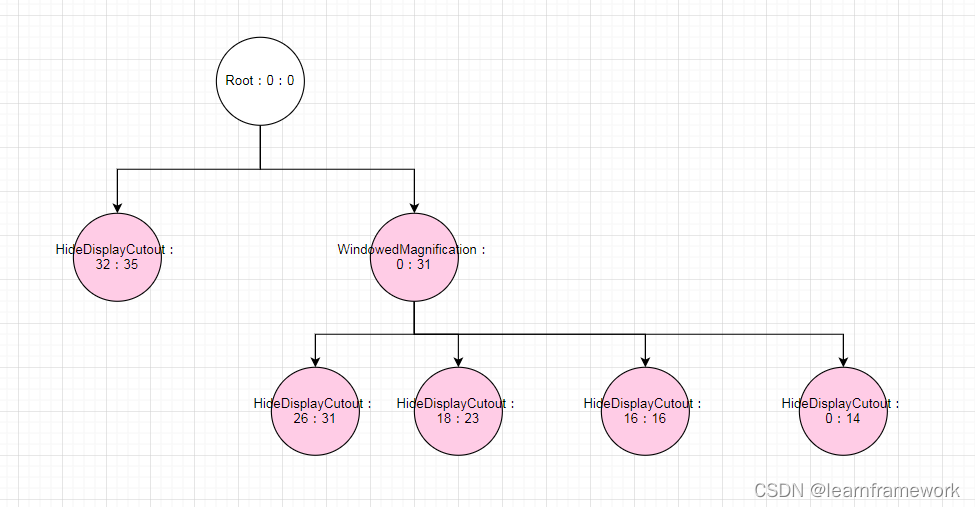
因为32-35层上一个Feature并没有覆盖
OneHanded 0-23 26-32 34-35
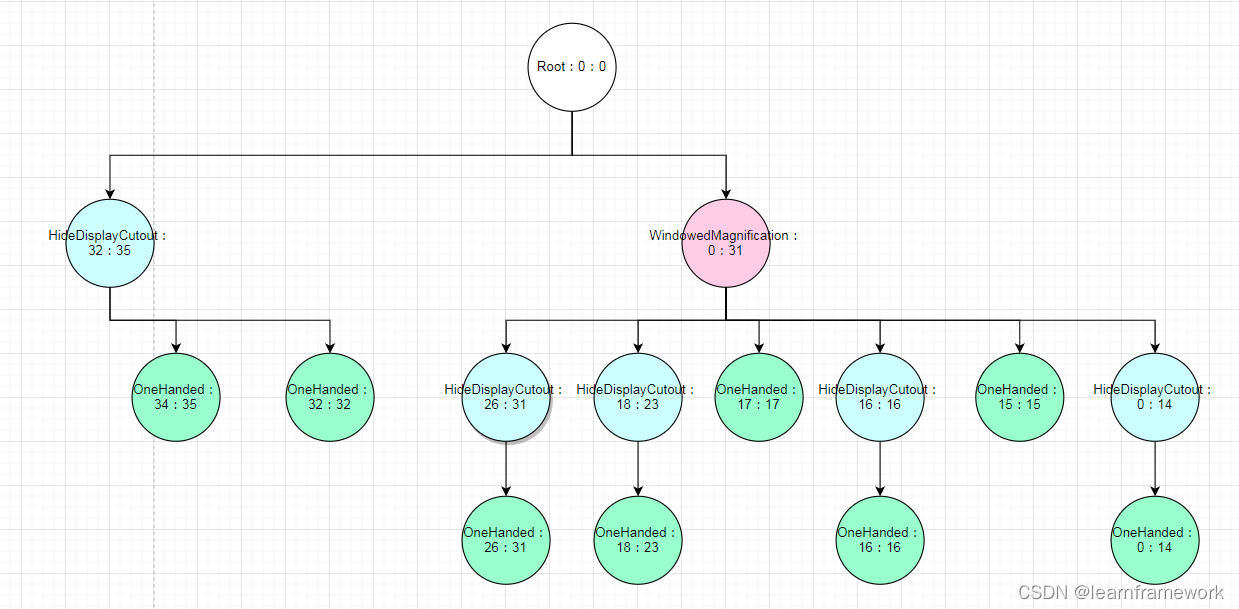
FullscreenMagnification 0-12 15-23 26-27 29-31 33-35
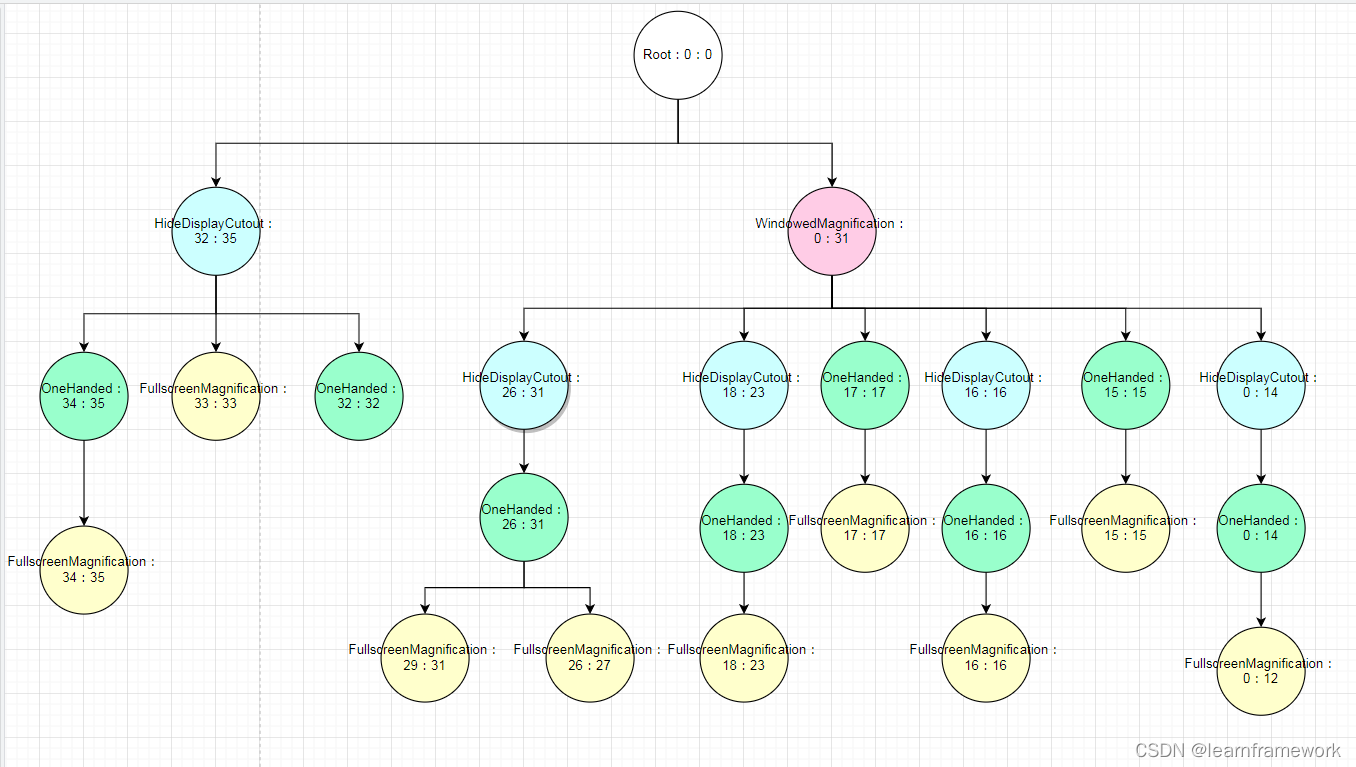
ImePlaceholder 13-14
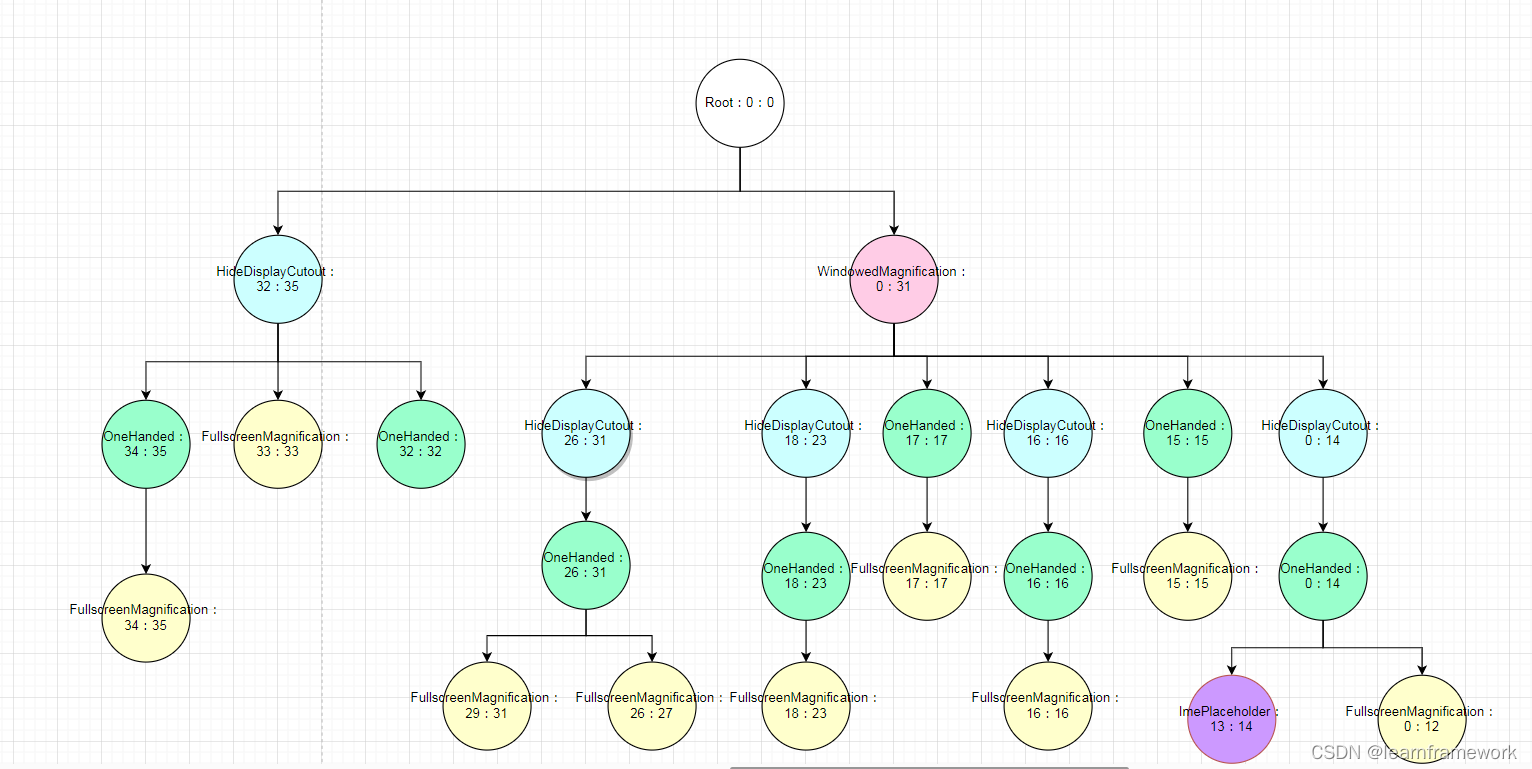
2、Feature构造完成也要对应的一些特殊的进行配置,除了TaskDisplayArea和ImeContainer特殊外,其他的给每个后面都给个Tokens
这个部分较为简单一些,基于上面已经根据Feature构建的树统一需要加上一个Tokens节点,但是要除去TaskDisplayArea和ImeContainer的两个部分
// Create Tokens as leaf for every layer.
PendingArea leafArea = null;
int leafType = LEAF_TYPE_TOKENS;//统一初始中为LEAF_TYPE_TOKENS
for (int layer = 0; layer < maxWindowLayerCount; layer++) {//遍历36层
int type = typeOfLayer(policy, layer);//获取每层的type是什么
// Check whether we can reuse the same Tokens with the previous layer. This happens
// if the previous layer is the same type as the current layer AND there is no
// feature that applies to only one of them.
//条件1针对leafArea空,或者leafArea本身不和这个layer共用一个父节点
//条件2针对属于TYPE_INPUT_METHOD APPLICATION_LAYER特殊处理
if (leafArea == null || leafArea.mParent != areaForLayer[layer]
|| type != leafType) {
// Create a new Tokens for this layer.
//以下代码相应想给每一层都挂载一个PendingArea
leafArea = new PendingArea(null /* feature */, layer, areaForLayer[layer]);//创建新的PendingArea,并挂载到areaForLayer[layer]下面
areaForLayer[layer].mChildren.add(leafArea);
leafType = type;
if (leafType == LEAF_TYPE_TASK_CONTAINERS) {
//APPLICATION_LAYER单独处理,就是前面设置过的TaskDisplayArea
// We use the passed in TaskDisplayAreas for task container type of layer.
// Skip creating Tokens even if there is no TDA.
addTaskDisplayAreasToApplicationLayer(areaForLayer[layer]);//设置本身已经设置过的TaskDisplayArea单独处理
addDisplayAreaGroupsToApplicationLayer(areaForLayer[layer],
displayAreaGroupHierarchyBuilders);
leafArea.mSkipTokens = true;//设置跳过
} else if (leafType == LEAF_TYPE_IME_CONTAINERS) {
// We use the passed in ImeContainer for ime container type of layer.
// Skip creating Tokens even if there is no ime container.
leafArea.mExisting = mImeContainer;//设置本身已经设置过的mImeContainer
leafArea.mSkipTokens = true;//设置跳过
}
}
leafArea.mMaxLayer = layer;
}
//根据层级获取type,这里只对特殊的APPLICATION_LAYER和TYPE_INPUT_METHOD有特殊,其他都是LEAF_TYPE_TOKENS
private static int typeOfLayer(WindowManagerPolicy policy, int layer) {
if (layer == APPLICATION_LAYER) {
return LEAF_TYPE_TASK_CONTAINERS;
} else if (layer == policy.getWindowLayerFromTypeLw(TYPE_INPUT_METHOD)
|| layer == policy.getWindowLayerFromTypeLw(TYPE_INPUT_METHOD_DIALOG)) {
return LEAF_TYPE_IME_CONTAINERS;
} else {
return LEAF_TYPE_TOKENS;
}
}
/** Adds all {@link TaskDisplayArea} to the application layer. */
private void addTaskDisplayAreasToApplicationLayer(PendingArea parentPendingArea) {
final int count = mTaskDisplayAreas.size();//这里一般等于1
for (int i = 0; i < count; i++) {
PendingArea leafArea =
new PendingArea(null /* feature */, APPLICATION_LAYER, parentPendingArea);//创建新的APPLICATION_LAYER的PendingArea,并挂载到parentPendingArea下面
leafArea.mExisting = mTaskDisplayAreas.get(i);//和前面IME一样把容器设置进去
leafArea.mMaxLayer = APPLICATION_LAYER;//设置最大Layer
parentPendingArea.mChildren.add(leafArea);//添加为父节点的孩子
}
}
}
上面代码执行完成后基本Pending树就构造完成,但这个时候还是PendingArea还不是真正DisplayArea,而且当前根节点只是个Root:0:0,根本不是我们DisplayContent,继续看build还剩下以下几步
root.computeMaxLayer();//会计算出每个节点最大layer值
// We built a tree of PendingAreas above with all the necessary info to represent the
// hierarchy, now create and attach real DisplayAreas to the root.
root.instantiateChildren(mRoot, displayAreaForLayer, 0, featureAreas);//这里会对把PendingArea生成DisplayArea,这里的参数mRoot就是我们的DisplayContent,root是Root:0:0这个PendingArea
这里重点看看 root.instantiateChildren(mRoot, displayAreaForLayer, 0, featureAreas);
void instantiateChildren(DisplayArea<DisplayArea> parent, DisplayArea.Tokens[] areaForLayer,
912 int level, Map<Feature, List<DisplayArea<WindowContainer>>> areas) {
913 mChildren.sort(Comparator.comparingInt(pendingArea -> pendingArea.mMinLayer));
914 for (int i = 0; i < mChildren.size(); i++) {
915 final PendingArea child = mChildren.get(i);
916 final DisplayArea area = child.createArea(parent, areaForLayer);
//这里可能create出来为null情况,比如前面说的ImeContainer,和DefaultTaskDisplayArea
917 if (area == null) {
918 // TaskDisplayArea and ImeContainer can be set at different hierarchy, so it can
919 // be null.
920 continue;
921 }
922 parent.addChild(area, WindowContainer.POSITION_TOP);//把返回的area设置为Child
923 if (child.mFeature != null) {
924 areas.get(child.mFeature).add(area);//同时也放入一下Feature集合
925 }
926 child.instantiateChildren(area, areaForLayer, level + 1, areas);//迭代子节点
927 }
928 }
929
930 @Nullable
931 private DisplayArea createArea(DisplayArea<DisplayArea> parent,
932 DisplayArea.Tokens[] areaForLayer) {
933 if (mExisting != null) {//Ime和DefaultTaskDisplayArea可以进入,针对已经存在mExisting直接使用它返回
934 if (mExisting.asTokens() != null) {//判断是否属于Tokens类型,其实就是ImeContainer
935 // Store the WindowToken container for layers
936 fillAreaForLayers(mExisting.asTokens(), areaForLayer);//给对应覆盖的层级都需要赋值为mExisting
937 }
938 return mExisting;//返回之前设置的
939 }
940 if (mSkipTokens) {//如果被设置了跳过的直接返回null
941 return null;
942 }
943 DisplayArea.Type type;
944 if (mMinLayer > APPLICATION_LAYER) {
945 type = DisplayArea.Type.ABOVE_TASKS;
946 } else if (mMaxLayer < APPLICATION_LAYER) {
947 type = DisplayArea.Type.BELOW_TASKS;
948 } else {
949 type = DisplayArea.Type.ANY;
950 }
951 if (mFeature == null) {
952 final DisplayArea.Tokens leaf = new DisplayArea.Tokens(parent.mWmService, type,
953 "Leaf:" + mMinLayer + ":" + mMaxLayer);//构造对应Tokens
954 fillAreaForLayers(leaf, areaForLayer);//给对应覆盖的层级都需要赋值为leaf
955 return leaf;
956 } else {
957 return mFeature.mNewDisplayAreaSupplier.create(parent.mWmService, type,
958 mFeature.mName + ":" + mMinLayer + ":" + mMaxLayer, mFeature.mId);//这里一般是构造对应DisplayArea
959 }
960 }
对于代码都给予了详细注释,这里就只做个总结:
1、根据窗口层级37层,每一层进行遍历,挂载一个新的叶子TOKENS节点,规则和前面Feature一样,如果同一个父亲则不需要新生成
2、针对TYPE_INPUT_METHOD APPLICATION_LAYER需要进行特殊处理
那么综上其实可以得出以下图(红色的Leaf就是新添加的,还有ImeContainer和DefaultTaskDisplayArea):

更多推荐
 已为社区贡献4条内容
已为社区贡献4条内容


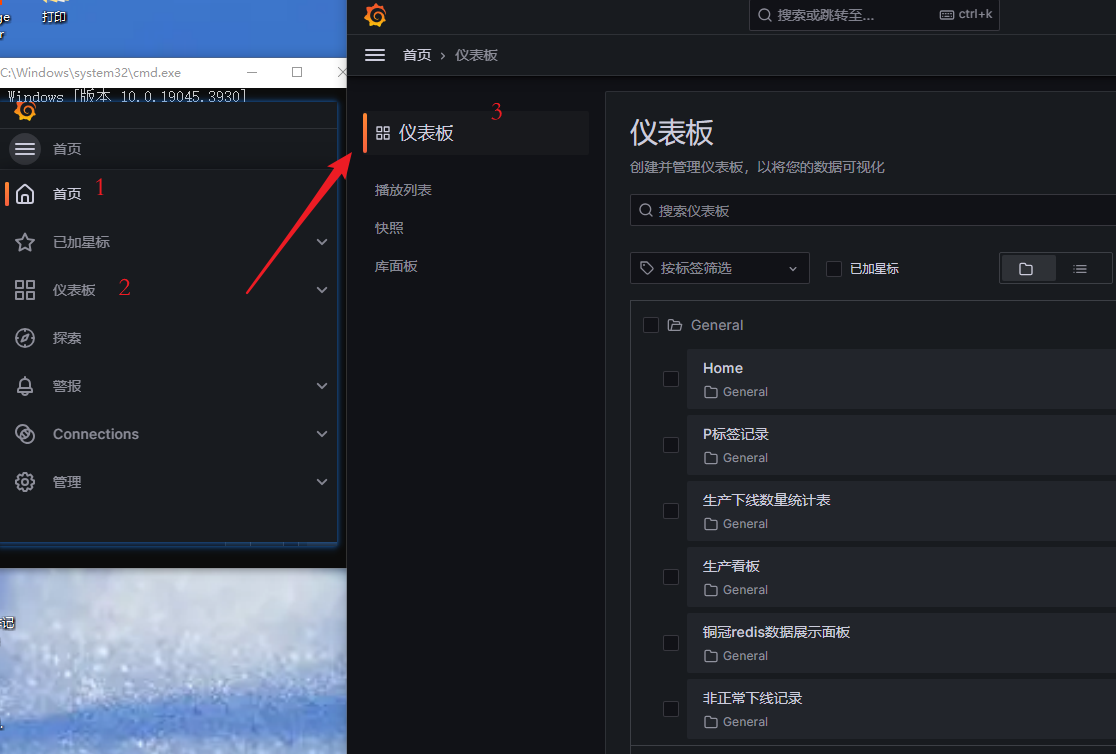





所有评论(0)